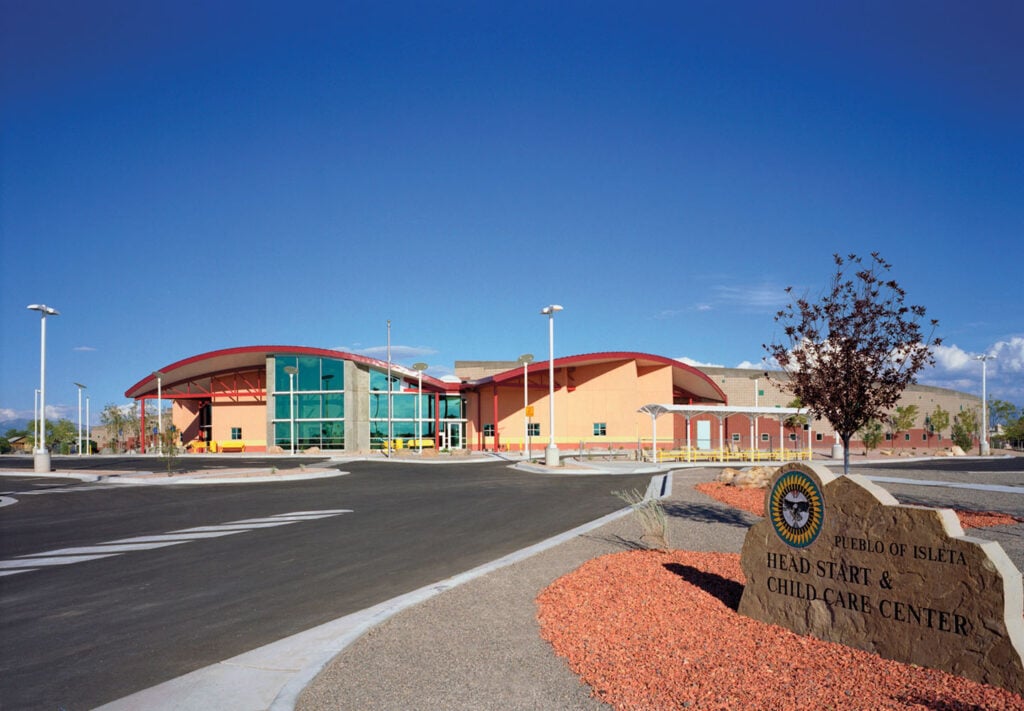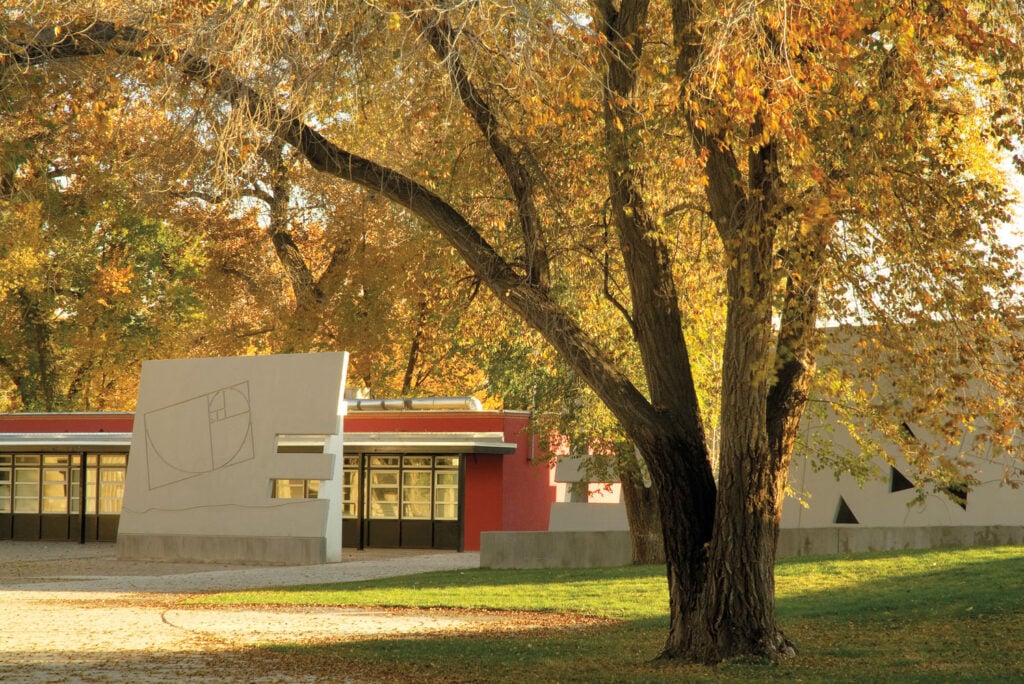
September 7, 2021
A Pioneering Exhibition Will Showcase Contemporary Indigenous Architecture
To understand Pueblo architecture is to understand the Pueblo ethos.
The unprecedented construction boom that resulted helped to elevate the role of culture and identity in placemaking on tribal lands. Prior to this, there were a total of seven Pueblo individuals trained in architecture. It also inspired a new movement among an emerging generation of young Pueblo practitioners to become educated and licensed in the field of architecture.

A PUEBLO ARCHITECTURAL WORLDVIEW
Popular culture has dominated the understanding of Indigenous communities in the Americas. Everyone is familiar with certain kinds of indigenous architecture—igloos, longhouses, hogans, tepees, and so-called “Anasazi” houses are among the most enduring examples. But aside from them, the general public knows little about traditionally influenced buildings that have emerged in the modern era. Overall, contemporary Indigenous architecture is a neglected field of inquiry that barely figures in the theory, history, and education of American architecture.
In the Pueblo context, the term “architecture” embodies more than a building’s form, function, and decoration. Architecture does not stand separate from other landscape elements around it. During one of her last interviews, in 2014, architect Rina Swentzell of Santa Clara Pueblo reflected on how traditional stories, songs, and prayers describe a world in which a house or structure is not merely an object but part of a cosmological worldview. Such architecture recognizes multiplicity, simultaneity, inclusiveness, and interconnectedness with the cultural landscape.
To understand Pueblo architecture is to understand the Pueblo ethos. Within a Pueblo worldview, architecture is often referred to as ceremony because it is the manifestation of a collective will and spirit. Buildings embody the life force of community. Such traditions are still witnessed in the present-day Shalako houses at the Pueblo of Zuni. Constructed by families who pledge their resources and labor, these new Shalako homes receive the mountain spirits during the winter solstice in ceremonial rites that make them ready for human habitation.

Pueblo Bonito was begun around AD 800 and took 140 years to complete. Archaeological evidence indicates that it was constructed in seven distinct phases—hence 20-year increments adding up to seven generations. Clearly, those who started the village did not live long enough to see its completion. Yet each successive generation stayed true to its original plan. Such a masterful accomplishment cannot adequately be characterized as placemaking and is better described by the concept of placeknowing.
“Placeknowing” is a term that grew out of national conversations with other Indigenous designers. It is defined as a place whose meaning is derived from a cultural construction. It is the result of a holistic understanding of how places evolve through time and space. Although it emerges from the placemaking conceptual framework, placeknowing a cultural landscape is informed by the wisdom of ancestors.
In a manner of reckoning, therefore, this collective intergenerational process also explains why Pueblo architects throughout the millennia were anonymous. Unlike the Spanish colonizers who settled the region and took instruction from the new township ordinances, Pueblo people had already used their traditional knowledge and science to attune their built environments to a sense of place.
Even though these examples are drawn from prehistoric sites and early historical records, examples of living villages that continue these building practices are still found at Pueblo villages like Acoma Sky City and Taos Pueblo, a World Heritage site.

CONTEMPORIZING PUEBLO ARCHITECTURE
In 2000, a 34-year-old woman from the Pueblos of Laguna and Isleta successfully defended her master’s thesis in architecture at the University of New Mexico. The subject of her work was a conceptual design for a new Head Start building at the Pueblo of Isleta.
The student’s name was Janet Carpio and she was among a handful of aspiring Indigenous graduates who chose design over many other competing fields. Upon graduation, she was hired as an architectural apprentice at the Albuquerque firm of Cherry/See/Reames. Under the mentorship of her senior colleagues, she was able to take the project from concept to construction, fulfilling a need to replace a substandard Bureau of Indian Affairs elementary school facility (ca. 1920) used by the Head Start program.
In 2004, the new 21,000-square-foot building was dedicated. What is remarkable about this building is that it represented a catharsis of placeknowing for Carpio. Although she grew up outside her Isleta ancestral home, the building’s program was informed by the Tiwa worldview of the community. To accomplish her task, she had to immerse and reacquaint herself with the lifeways of the Isleta community.

The principal cultural elements that she incorporated into the design included siting the homerooms so that they are entered from the east—the direction of the sunrise that represents the beginning of the life cycle. The hallways and skylights are aligned with the winter and summer solstices.
The building also has a center place, an open circle where staff, parents, and children can congregate. It is a metaphorical representation of the village plaza or ceremonial heart place. In her design, Carpio uses colored floor patterns to represent the four cardinal directions as well as a palette of blue (water), brown (earth), and green (crops).
Children from infants to five-year-olds begin their educational journey at the center place. As they grow, they advance their learning in a series of classrooms, simulating a counterclockwise path along the Pueblos’ ancestral migration route. Carpio’s role is subsumed, less that of an architect in the Western tradition and more that of a cultural matriarch giving form and meaning to a sense of place.
Another example of contemporary Pueblo design is the Owe’neh Bupingeh housing project at Ohkay Owingeh Pueblo. When the project began in 2005, fewer than a dozen homes were occupied around the traditional village plaza or heart place. Most of the adobe structures were vacant and crumbling, while others were occupied only when ceremonies or cultural activities took place.
The village was a victim of decades of housing policies from the Department of Housing and Urban Development (HUD), which introduced wood-frame construction and detached single-family dwellings around the periphery of the old village. In some instances, HUD requirements forced families to demolish their traditional adobe houses before they could qualify for new housing.

The result was a noticeable decline in village life. Once centered on the plaza, families moved away and were forced to succumb to a car-centric, wage-driven lifestyle. As the adobe structures deteriorated over time, a sense of identity also waned, especially for children. These trends affected the retention of their language as well as contributing to an overall sense of malaise in the community’s health and well-being.
Although the director of the Tribal Housing Authority, Tomasita Duran (Ohkay Owingeh), is not an architect, she is the visionary behind the revitalization of the old village. The goal was to reorient the community back toward its traditional heart place by remodeling the dilapidated buildings and rebuilding infrastructure to support modern amenities.
Perhaps the most far-reaching aspect of the program was the partnership role the Tribal Housing Authority took with tribal leadership to advocate and reassign vacant houses among younger families. Upwards of 40 houses have been remodeled, using uncompromising adobe standards that rely on traditional mud plaster and local building techniques.
Among these are historic preservation standards for windows and doorways. Foundations were redone without compromising the integrity of existing adobe walls. Damaged walls were reconstructed instead of being replaced. Pine roof timbers, or vigas, were refurbished, especially after it was learned that their placement was the result of collective community efforts to bless their occupants. Most importantly, new owners were educated on how to apply mud-plaster techniques annually to preserve the buildings. This was necessary for undoing the damage that had inadvertently been caused by using outside concrete stucco. In this manner, village life has been successfully reawakened.
Would you like to comment on this article? Send your thoughts to: [email protected]
Latest
Profiles
WAI Architecture Think Tank Approaches Practice as Pedagogy
Nathalie Frankowski and Cruz García use their practice to help dismantle oppressive systems, forge resistance spaces, and reimagine collective futures.
Products
Functional Beauty: Hardware That Does More Than Look Good
Discover new standout pieces that marry form and function, offering both visual appeal and everyday practicality.
Profiles
The Next Generation Is Designing With Nature in Mind
Three METROPOLIS Future100 creators are looking to the world around them for inspiration.










